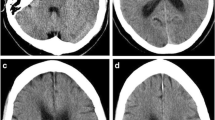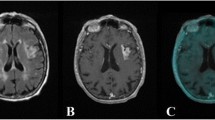Abstract
The purpose of this study is to confirm whether T2-weighted imaging and perfusion imaging, i.e. autoradiogram of14C-iodoantipyrine, on the course of brain edema correspond to each other or not. Cold injured rat brains were used as a model and were sequentially examined by both methods and compared with each other and with histological specimens. Special focus relies on the time changes in the lesions. High SI of T2-weighted images were observed and the percentages in the high SI area to the total brain area in the same slice were 4.7±0.31, 5.6±0.46 and 3.4±0.42 for 6,24 and 48 hours, respectively. By contrast, low perfusion areas were indicated in the perfusion study and their percentages were 4.6±0.55, 5.6±0.86 and 2.4±0.35 for 6,24 and 48 hours, respectively. At 48 hours after cold injury, low perfusion areas were smaller than high SI areas. Moreover, high accumulation areas consisting of macrophages were observed surrounding necrosis. It is concluded that there is dissociation between perfusion and T2-weighted MR imaging, where the collection of macrophages surrounding edema lesions and necrosis had the same appearance on MRI and different accumulations on perfusion studies.
Similar content being viewed by others
References
Benderson JB, Bartkowski HM, Moon K, Halks-Miller M, Nishimura MC, Brant-Zawadski M, et al. Nuclear magnetic resonance imaging and spectroscopy in experimental brain edema in a rat model.J Neurosurg 1986; 64: 795–802.
Kamada K: Sequential observations of brain edema with proton magnetic resonance imaging and spectroscopy.Hokkaido Igaku Zasshi 1996; 71 (1): 105–122.
Ebisu T, Naruse S, Horikawa Y, Ueda S, Tanaka C, Uto M, et al. Discrimination between different types of white matter edema with diffusion weighted MR imaging.JMRI 1993; 3: 863–868.
Pierpaoli C, Righini A, Linfante I, Tao-Cheng JH, Alger JR, Di Chiro G. Histopathologic correlates of abnormal water diffusion in cerebral ischemia: Diffusion-weighted MR imaging and light and electron micriscopic study.Radiology 1993; 189: 439–448.
Asato R, Handa H, Hashi T, Hatta J, Komoike M, Yazaki T. Chronological sequences and blood-brain barrier permeability changes in local injury as assessed by nuclear magnetic resonance (NMR) images from sliced rat brain.Stroke 1983; 14: 191–197.
Hashimoto K, Yamagata S, Minamikawa J, Watanabe Y, Kanesiro M, Kikuchi H. The effect of Gd-DTPA on magnetic resonance imaging: a potential blood-brain barrier indicator.No Shinkei 1988; 40 (5): 461–466.
Ogawa T. Effect of stimulation of the medullary reticular formation on brain water content in cold induced brain.No Shinkei 1990; 40 (3): 261–268.
Frei HJ, Wallenfang TH, Poll W, Reulen HJ, Schubert R, Brock M: Regional cerebral blood flow and regional metabolism in cold induced oedema.Acta Neurochir 1973; 29: 15–28.
Kagawa M, Nagao S. The effect of arginine vasopressin receptor on the rat cold-injured brain.No Shinkei Geka 1993; 21 (12): 1103–1107.
Houkin K, Abe H, Hashiguchi Y, Seri S. Magnetic resonance imaging of cold-induced brain edema in rats.Neurol Med Chir (Tokyo) 1996; 36: 72–77.
Sakurada O, Kennedy C, Jehle J, Brown JD, Carbin GL, Sokoloff L. Measurement of local cerebral blood flow with iodo [14C] antipyrine.Am J Physiol 1978; 234 (1): H59-H66.
Sako K. Strategies for measurement of cerebral blood flow and metabolism using autoradiography.No Shinkei Geka 1993; 21 (6): 484–490.
Ito J, Marmarou A, Barzo P, Fatouros P, Corwin F. Characterization of edema by diffusion-weighted imaging in experimental traumatic brain injury.J Neurosurg 1996; 84: 97–103.
Cancilla PA, Frommes SP, Kahn LE, DeBault LE. Regeneration of cerebral microvessels.Lab Investig 1979; 40 (1): 74–82.
Murakami K, Kondo T, Sato S, Li Y, Chan PH. Occurrence of apoptosis following cold injury-induced brain edema in mice.Neuroscience 1997; 81 (1): 231–237.
Nag S. Cold-injury of the cerebral cortex: Immunolocalization of cellular proteins and blood-barrier permeability studies.J Neuropathol Exp Neurol 1996; 55 (8): 880–888.
Olson JJ, Beck DW, Warner DS, Coester H. The role of new vessels and macrophages in the development and resolution of edema following a cortical freeze lesion in the mouse.J Neuropathol Exp Neurol 1987; 46 (6): 682–694.
Mitchell J, Weller RO, Evans H. Reestablishment of the blood brain barrier to peroxidase following cold injury to mouse cortex.Acta Neuropathol 1979; 46: 45–49.
Author information
Authors and Affiliations
Rights and permissions
About this article
Cite this article
Itabashi, Y., Prado, G.L.M., Abo, M. et al. Dissociation of brain edema induced by cold injury in rat model: MR imaging and perfusion studies with14C-iodo-antipyrine. Ann Nucl Med 15, 337–342 (2001). https://doi.org/10.1007/BF02988240
Received:
Accepted:
Issue Date:
DOI: https://doi.org/10.1007/BF02988240




